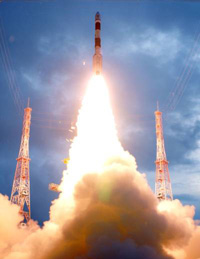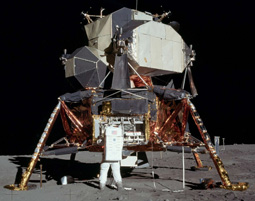
On Oct. 22, 2008, India successfully launched the spacecraft Chandrayaan-1 from the Satish Dhawan Space Centre on the Bay of Bengal.

Watching astronauts Neil Armstrong and Buzz Aldrin walk on the moon captured my imagination in a way that no toy, television show or movie ever could.
I wonder how many children in India will be similarly inspired by the success of that country’s first lunar mission? On Oct. 22, 2008, India successfully launched the spacecraft Chandrayaan-1 from the Satish Dhawan Space Centre on the Bay of Bengal. Built by theIndian Space Research Organization(ISRO), Chandrayaan-1 is currently orbiting the moon on a two-year mission to map the lunar surface and determine its mineral content.
The spacecraft carries 11 instruments: three from the European Space Agency, two from NASA, one from Bulgaria and five from the ISRO. In addition, the satellite carried the Moon Impact Probe, which was jettisoned to land on the lunar surface before the mapping mission began. The probe will give ISRO scientists experience to be used in subsequent lunar landing missions. To read more about the spacecraft’s mission, clickhere.
Of course, one could argue that the Indian government has more urgent needs than spaceflight on which to devote its resources. For example, of the world’s 193 nations, India has the 67th highest adult mortality rate, according to the World Health Organization. (On the other hand, Russia has the 43rd highest, which is worse than Sudan, Gambia and Haiti. Shame on you, Putin!)
Still, you have to admire India’s accomplishment. And if the ISRO is anything like NASA, the Indian economy will benefit from the country’s success in space. Since 1976, more than 1,500documented NASA technologieshave benefited U.S. industry, improved the quality of life, and created jobs. There’s no doubt the program changed our way of life in America.
In 1957, the Soviet Union’s launch of Sputnik 1 caused a sensation in the United States and spurred unprecedented technological innovation. I hope India’s successful lunar mission causes a similar stir. I’m not suggesting that the United States begin another space race. Rather, I hope it serves as a clarion call for U.S. manufacturers to continue investing in technological innovation.

Recent Comments
Helpful for Trainees
Cable Assembly Manufacturers
Huawei for manufacturing?
should have a scanner and then 3D print the repair
IPC-A-610 and IPC-j-std-001